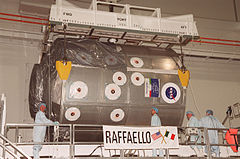Raffaello MPLM
 Raffaello being prepared for flight on STS-100 | |
| Operator | NASA |
|---|---|
| Website | NASA MPLM |
| Mission duration | ~2 weeks |
| Spacecraft properties | |
| Spacecraft | Raffaello |
| Spacecraft type | MPLM |
| Manufacturer | ASI |
| Dry mass | 4,082 kilograms (8,999 lb)[1] |
| Orbital parameters | |
| Reference system | Geocentric |
| Regime | Low Earth |
| Inclination | 51.7° |
| Berthing | |
The Raffaello MPLM, also known as MPLM-2, was one of three
Leonardo being used for the remainder. It was first launched on 19 April 2001, aboard the STS-100 mission flown by Space Shuttle Endeavour, and made its third flight in July 2005, aboard Discovery on STS-114. Raffaello's final flight was aboard Space Shuttle Atlantis on the STS-135
mission, the last flight of the Space Shuttle.
In April 2023, Raffaello was transferred to Axiom Space to be repurposed and flown as part of the Axiom Orbital Segment.[2]
Construction
Like the other Multi-Purpose Logistics Modules, Raffaello was constructed by the Italian Space Agency, who chose to name it after the painter and architect Raffaello Sanzio.[1] The module was constructed in the late 1990s, and delivered to NASA at the Kennedy Space Center in August 1999.[3]
Flights

| Mission | Orbiter | Launch (UTC)[4] | Landing (UTC) |
|---|---|---|---|
| STS-100 | Endeavour | 19 April 2001 | 1 May 2001 |
| STS-108 | Endeavour | 5 December 2001 | 17 December 2001 |
| STS-114 | Discovery | 26 July 2005 | 9 August 2005 |
| STS-135 | Atlantis | 8 July 2011 | 21 July 2011 |
See also
- Permanent Multipurpose Module
- Leonardo MPLM
References
- ^ a b "What is MPLM?". NASA Marshall Space Flight Center. Archived from the original on 27 May 2010. Retrieved 17 May 2010.
- ^ Leinfelder, Andrea (2023-04-27). "NASA's Super Guppy delivers space shuttle module for reuse on Axiom Space's commercial station". Houston Chronicle. Retrieved 2023-04-27.
- ^ "Multi-Purpose Logistics Modules". International Space Station. NASA. Retrieved 17 May 2010.
- ^ McDowell, Jonathan. "Launch Log". Jonathan's Space Page. Retrieved 17 May 2010.

